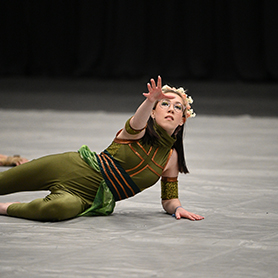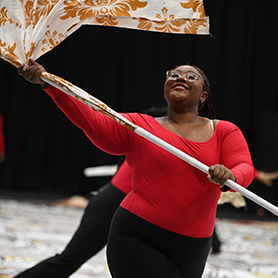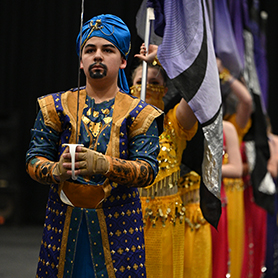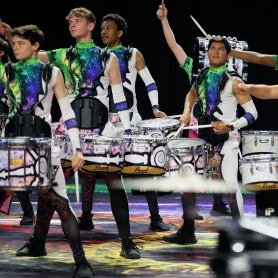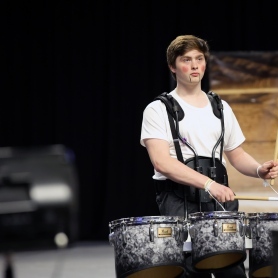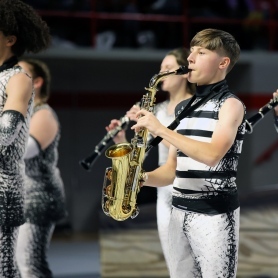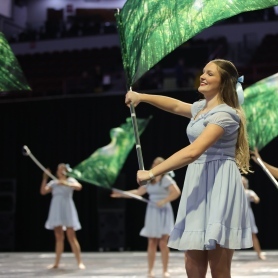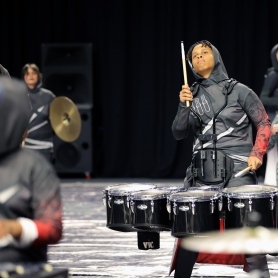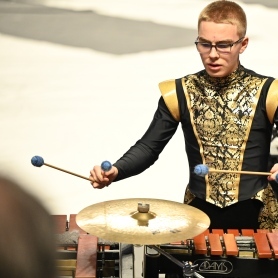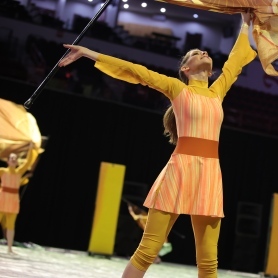A Brief History of the SCGC
In the early 1990's SCGC had a quarterly production called "SCGC Accolades". Attached to this article is the Fall 1990 edition which includes a brief history of the Southeastern Color Guard Circuit!
Check out a scanned copy of the original by clicking the link above. A retyped version also follows.
The History of The SCGC, First Decade
by Robert Robinson
I had planned to write a very factual history of the SCGC, but after much thought, realized that would be next-to impossible and would probably develop into a boring article as well. Instead, I contacted several people mentioned in this article to use as sources and combined that with how one person was affected by participation in the SCGC. One evening in 1971 at a Shoney's Restaurant in Birmingham, Alabama, the SCGC was formed by Doug Noel, John Armstrong, Frank Godfrey and Jim Gladson. These men patterned after an exciting idea from the Midwestern United States, The Midwest Colorguard Circuit. At that time, the units were judged in General Effect, Marching and Maneuvering, and Timing and Penalty. The "tick" system was used to subtract errors from the M & M. Each unit had to perform to the cadence of their marching. Also, each unit was required to execute two of the following moves which were based on American Flag codes of the VFW and American Legion.
Pass and Review -"units pass through an area 12 feet of the center line in a company front with each member executing eyes right and rendering the proper salute."
Post and Retrieve Colors -"units must post and retrieve all flags using flag stands and set-up of its own design. Other maneuvers may be done at this time but there is a maximum of 60 seconds."
Presentation of Colors -"units must pay respect to our National Color by halting facing the GE side with all members rendering the proper salute, highlighting the U.S. Flag."
In 1972, the first guards were the Jones Valley High School Rangers of Birmingham, directed by Doug Noel, Talledega High School directed by Frank Godfrey, Cordova High School directed by John Armstrong, Tate High School of Gonzalez, Florida, directed by Mike Strasser, and a guard from Alabama Christian College. In the first Championship, held at Alabama Christian College, the winner was Cordova High School.
In the first years of the SCGC winners included
Past Champions
- 1972-Cordova High School, Alabama
- 1973 Charioteers-Troy, Ala. (affiliated with the drum corps)
- 1974 & 1975 Golden Eagles-Jacksonville, AI.
In 1974 the rules were changed to allow guards to also be accompanied by live instrumentation (drums) in addition to their marching cadence.
Though I did not begin the circuit until 1975, I remember that Cordova High School's 1973 & 74 guards, the Coronets and the Imperials, were fierce competitors with the Golden Eagles, the Handleyans, and Decorum of Fairfield, Alabama. The Golden Eagles were noted for their excellent rifle lines and even placed at Midwest Finals. The Golden Eagles were also used in a demonstration film produced by the Midwest Colorguard Circuit. Decorum, in purple hot pants jumpsuits with the cross-style white belting and holsters, were noted for their exceptionally high mark time and ease of execution.
Decorum patterned their uniforms after the Blue Stars Drum Corps. Decorum won High M & M in 1974. My sister, a marching member of the Coronets, remembers standing at attention for five minutes (she swears) waiting on the judges' cue to begin their championship performance. (The Coronets placed first runner-up to the Golden Eagles, as a result of this nerve-wracking experience). Rules were later added to permit a guard to exit and re-enter in such cases. In 1974, the circuit was divided into two classes. Also interesting to the circuit were the Thunderbolts of New Orleans, Louisiana. This all black unit was sponsored by the Police League of their city.
In 1975, the circuit grew to include Alabama guards such as The Southern Lancers from Jacksonville State, the Hokes Bluff Raiders, Emma Sansom High School Rebels, The Pirates of Boaz,and the Emerald Knights and Imperials of Cordova. From Georgia came guards such as The Blue Eagles of South Cobb and The Catamounts of Dalton High School. From Louisiana came the Los Cumancheros and Dimensions of New Orleans, and the L' Acadiennes of Lafayette.
From Florida came the Miami Silhouettes, Chargers, and the Devil Dogs of Clearwater. From Tennessee came the Blue Devils of Erwin High School. Unique to the circuit that year were the two all-male guards, the Emerald Knights and Los Cumancheros. Adopting the look from the drum corps by the same name, The Emerald Knights wore green pants with red satin shirts and marched out entertaining rhythms such as "The Big Bad Wolf" and "Pop Goes The Weasel". Los Cumancheros were unique in their Spanish bullfighter uniforms and their use of a trumpet fanfare and percussion accompaniment. I also remember that Tate wore black hot pants, white blouses, and red vests. Tate's uni form was finished off with white knee-high majorette boots th at were quite in fashion at the time. We were also impressed that Tate had two guards from the same school! One of the most intimidating groups for the year was the Silhouettes of Miami. Coming also from the drum corps by the same name, the Silhouettes wore orange and green uniforms and short white majorette boots. The excellence of mark time displayed by the Silhouettes was thunderous and frightened many competitors into lower scores by comparison. The Silhouettes brought out the innovative use of 5 foot flag poles, while all of the other groups were still using eight foot poles!
In 1976, recorded music was allowed to accompany the guards' routines. Most guards chose classical favorites. Though there was variety, too. Les Brae chose musical selections from "The Allman Brothers" and "King Henry V". What a mix! The Golden Eagles performed to a high energy version of "Night On Bald Mountain". The Los Cumancheros deviated from the traditional by using "I've Never Been To Spain" by Three Dog Night, but mid season changed back to mainstream Spanish. The great upsets for the year included Cordova's Les Brae's drop from a prelim third to eighth place in championships due to a 2 point American flag violation and the defending champions Golden Eagles drop to second behind the Southern Lancers. The Golden Eagle Cadets did win Class A for the second time in 1976.Third in Open were the Silhouettes. Open class Tate placed 4th and Tate A placed 3rd.
In 1977, new to the circuit was the class A guard Entrada. After wowing the circuit and winning SCGC championships, Entrada went on to compete in and win Midwest A Finals and also to win the High M & M trophy. It seems that the Midwest judges thought that Entrada was from Jasper, Michigan, and not Alabama, as a guard must be a member of the Midwest to win the event, as the story goes. Midwest was quite tough and turned out to be forerunner of WGI.
Also new that year in the SCGC were the Blue Knights of Alpine, Alabama. Sporting military shakos and cadet jackets, the Blue Nights wowed their audiences with "The Pink Panther". Other guards who entered the circuit that year were two groups from Mississippi: Korkoma and Charon Regime. Charon Regime was a co-ed college-aged guard with a fantastic rifle line performing in the classical style
By 1978, the circuit had grown to incorporate 3 classes. Leading the cl ass A pack were Entrada and the Tate Chaparrals. Tate gave outstanding performances in -rifle and marching to "Rodeo", whereas Entrada chose a more flowing but highly executed approach to music from the movie "Rocky" . Still hanging in were the Golden Eagles placing third throughout the season, that year going co-ed for the first time.
Open class in 1978 had the Southern Lancersand the L'Acadiennes battling it out for top spots. Unique to the circuit were the Chargers of Miami, donning rainbow colored wigs and interpreting the musical "The Wiz". Nightclub of Cordova, Alabama, brought to life "A night at the different clubs" performing dance selections from the "Ohio Players" , "Rhapsody in Blue", and a jazz arrangement of the Beatles' "Something". Brad Caraway of the Madison Scouts and Spirit of Atlanta served as Nightclub's director. Both guards were highly entertaining and were the first to bring a new element to the SCGC: dance!
Class B brought out a one year guard from St. Clair County, Alabama, the Saint's Crusaders. Leading the pack all season long, the Crusaders performed to "Star Wars" selections and wore military uniforms in burgundy and grey.
Then in 1979, dance was the wave. Out were classical selections, in was disco. Riding on the success of movies "Saturday Night Fever" and "The Wiz" ... all groups chose to forget classical and hit the new scene. Marching members Tam Easterwood of Alabama and Scott Chandler of Georgia were both attending Jacksonvillie State and decided that the Southern Lancers needed a new image for its fifth year: thus came Chapter V, still under the direction of Frank Godfrey, formerly of Decorum fame. Chapter V mixed classical and jazz/disco to become the SCGC's first WGI Open finalist guard!
Many high schools were entering new units that year as well. Florida brought out Crestview High School and Pensacola High School's Titanians; and Alabama brought out Tarrant High School's Blues. By now the circuit was divided into four classes. High School A guards were spectacular-the rivalry between contenders Tate and Entrada was fierce. Entrada, under the direction of Beverly Jones, continued to develop a style that was later to prove to be ahead of her time. Entrada performed abstract shows to jazz and classical music while utilizing a modern dance style, both in choreography and costuming. Tate continued to develop its traditional western themes and maintained its superb rilfle line, probably the best high school rifle line around. Scott Chandler turned the Hokes Bluff Raiders into Le Chic, went coed, and chose selections from "The Wiz".
Just as fierce in Class B the Blue Knights were competing with Innovation of Corner, AI., and Sentinel of Villa Rica, Georgia. It was vogue in Class B to have drill that symbolized the guard. The Blue Knights dropped the "K" and developed nighttime themes such as moons and stars. Sentinel and Innovation would develop creative ways to use "float drill" in the letters "S" and " I" respectively. But leading the pack out of all class B guards was Tate B: Tate B was topping some Open Class scores with numbers in the high 70s!, bringing back the popular "Rodeo". Other guards included Phoenix of Warrior, Alabama, and a whole class of novice guards.
The split between Florida and Louisiana guards from The Georgia, Alabama, Tennessee guards came at the end of the 1979 season . The SCGC had grown so large and the travel distances were tremendous-the circuit stretched from Miami to Knoxville!
Ready for the eighties was Chapter V's motto for 1980. Tam Easterwood had aged out and was serving as instructor. Scott Chandler was flag captain. Unfortun ate ly, Chapter V folded midseason, just after placing in the top 5 in Open at the Southern Regional and appearing ready to be WGI finalist for the second year in a row! Another guard emerged out of Jacksonville, Alabama that year-Triptych under the direction of Alan Casey.
Triptych consisted of members from JSU, Entrada veterans, and students from Warrior High School. Using "Magic Bird of Fire", the guard chose a hard-style, high-energy show concept.
A dominant high school guard for the year was Homewood, Alabama, underthe direction of Darryl Ushery, a former Southern Lancer who chose to bring back the classical military style of the Lancers to Homewood. Still in the high school class were Innovation, the Blue Nights, and Sentinel all battling weekly for trophies not taken by Homewood. And two other Birmingham High Schools, Fultondale and Gardendale, merged to form Zanzabar. Zanzabar was innovative by wearing genie costumes and performing an Arabian show.
Triptych won Open Class at SCGC Championships after battling with Entrada for the remainder of the season.
Thus, the first decade of the SCGC ended with over twenty-five member guards. The SCGC can boast a proud history of comradeship, excitement, and creativity, and can proudly say that many successful units and instructors are Southern born.


